Ziwei Zhao
School of Optometry, The Hong Kong Polytechnic University, Kowloon, Hong Kong SAR, China
LLM as GNN: Graph Vocabulary Learning for Text-Attributed Graph Foundation Models
Mar 05, 2025Abstract:Text-Attributed Graphs (TAGs), where each node is associated with text descriptions, are ubiquitous in real-world scenarios. They typically exhibit distinctive structure and domain-specific knowledge, motivating the development of a Graph Foundation Model (GFM) that generalizes across diverse graphs and tasks. Despite large efforts to integrate Large Language Models (LLMs) and Graph Neural Networks (GNNs) for TAGs, existing approaches suffer from decoupled architectures with two-stage alignment, limiting their synergistic potential. Even worse, existing methods assign out-of-vocabulary (OOV) tokens to graph nodes, leading to graph-specific semantics, token explosion, and incompatibility with task-oriented prompt templates, which hinders cross-graph and cross-task transferability. To address these challenges, we propose PromptGFM, a versatile GFM for TAGs grounded in graph vocabulary learning. PromptGFM comprises two key components: (1) Graph Understanding Module, which explicitly prompts LLMs to replicate the finest GNN workflow within the text space, facilitating seamless GNN-LLM integration and elegant graph-text alignment; (2) Graph Inference Module, which establishes a language-based graph vocabulary ensuring expressiveness, transferability, and scalability, enabling readable instructions for LLM fine-tuning. Extensive experiments demonstrate our superiority and transferability across diverse graphs and tasks. The code is available at this: https://github.com/agiresearch/PromptGFM.
GraphMorph: Tubular Structure Extraction by Morphing Predicted Graphs
Feb 17, 2025Abstract:Accurately restoring topology is both challenging and crucial in tubular structure extraction tasks, such as blood vessel segmentation and road network extraction. Diverging from traditional approaches based on pixel-level classification, our proposed method, named GraphMorph, focuses on branch-level features of tubular structures to achieve more topologically accurate predictions. GraphMorph comprises two main components: a Graph Decoder and a Morph Module. Utilizing multi-scale features extracted from an image patch by the segmentation network, the Graph Decoder facilitates the learning of branch-level features and generates a graph that accurately represents the tubular structure in this patch. The Morph Module processes two primary inputs: the graph and the centerline probability map, provided by the Graph Decoder and the segmentation network, respectively. Employing a novel SkeletonDijkstra algorithm, the Morph Module produces a centerline mask that aligns with the predicted graph. Furthermore, we observe that employing centerline masks predicted by GraphMorph significantly reduces false positives in the segmentation task, which is achieved by a simple yet effective post-processing strategy. The efficacy of our method in the centerline extraction and segmentation tasks has been substantiated through experimental evaluations across various datasets. Source code will be released soon.
A Foundational Generative Model for Breast Ultrasound Image Analysis
Jan 12, 2025



Abstract:Foundational models have emerged as powerful tools for addressing various tasks in clinical settings. However, their potential development to breast ultrasound analysis remains untapped. In this paper, we present BUSGen, the first foundational generative model specifically designed for breast ultrasound image analysis. Pretrained on over 3.5 million breast ultrasound images, BUSGen has acquired extensive knowledge of breast structures, pathological features, and clinical variations. With few-shot adaptation, BUSGen can generate repositories of realistic and informative task-specific data, facilitating the development of models for a wide range of downstream tasks. Extensive experiments highlight BUSGen's exceptional adaptability, significantly exceeding real-data-trained foundational models in breast cancer screening, diagnosis, and prognosis. In breast cancer early diagnosis, our approach outperformed all board-certified radiologists (n=9), achieving an average sensitivity improvement of 16.5% (P-value<0.0001). Additionally, we characterized the scaling effect of using generated data which was as effective as the collected real-world data for training diagnostic models. Moreover, extensive experiments demonstrated that our approach improved the generalization ability of downstream models. Importantly, BUSGen protected patient privacy by enabling fully de-identified data sharing, making progress forward in secure medical data utilization. An online demo of BUSGen is available at https://aibus.bio.
LarvSeg: Exploring Image Classification Data For Large Vocabulary Semantic Segmentation via Category-wise Attentive Classifier
Jan 12, 2025



Abstract:Scaling up the vocabulary of semantic segmentation models is extremely challenging because annotating large-scale mask labels is labour-intensive and time-consuming. Recently, language-guided segmentation models have been proposed to address this challenge. However, their performance drops significantly when applied to out-of-distribution categories. In this paper, we propose a new large vocabulary semantic segmentation framework, called LarvSeg. Different from previous works, LarvSeg leverages image classification data to scale the vocabulary of semantic segmentation models as large-vocabulary classification datasets usually contain balanced categories and are much easier to obtain. However, for classification tasks, the category is image-level, while for segmentation we need to predict the label at pixel level. To address this issue, we first propose a general baseline framework to incorporate image-level supervision into the training process of a pixel-level segmentation model, making the trained network perform semantic segmentation on newly introduced categories in the classification data. We then observe that a model trained on segmentation data can group pixel features of categories beyond the training vocabulary. Inspired by this finding, we design a category-wise attentive classifier to apply supervision to the precise regions of corresponding categories to improve the model performance. Extensive experiments demonstrate that LarvSeg significantly improves the large vocabulary semantic segmentation performance, especially in the categories without mask labels. For the first time, we provide a 21K-category semantic segmentation model with the help of ImageNet21K. The code is available at https://github.com/HaojunYu1998/large_voc_seg.
Case-Enhanced Vision Transformer: Improving Explanations of Image Similarity with a ViT-based Similarity Metric
Jul 24, 2024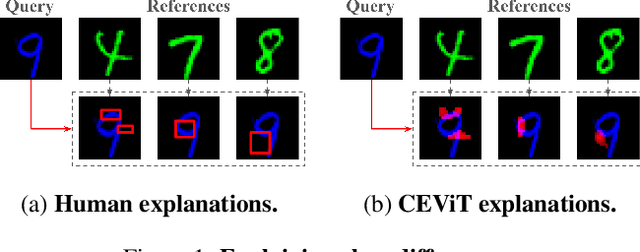



Abstract:This short paper presents preliminary research on the Case-Enhanced Vision Transformer (CEViT), a similarity measurement method aimed at improving the explainability of similarity assessments for image data. Initial experimental results suggest that integrating CEViT into k-Nearest Neighbor (k-NN) classification yields classification accuracy comparable to state-of-the-art computer vision models, while adding capabilities for illustrating differences between classes. CEViT explanations can be influenced by prior cases, to illustrate aspects of similarity relevant to those cases.
Knowledge-driven AI-generated data for accurate and interpretable breast ultrasound diagnoses
Jul 23, 2024
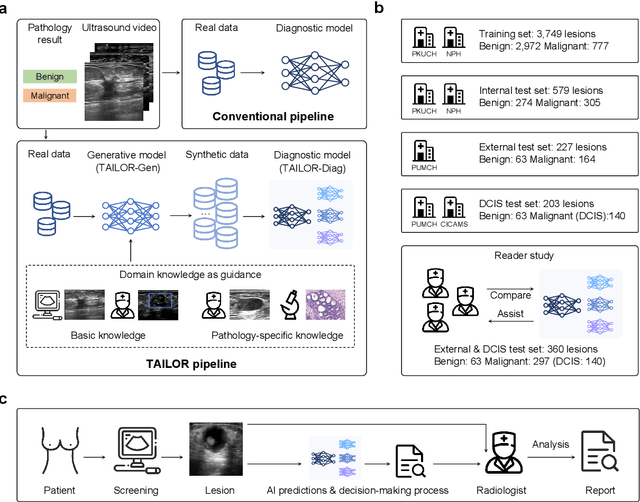
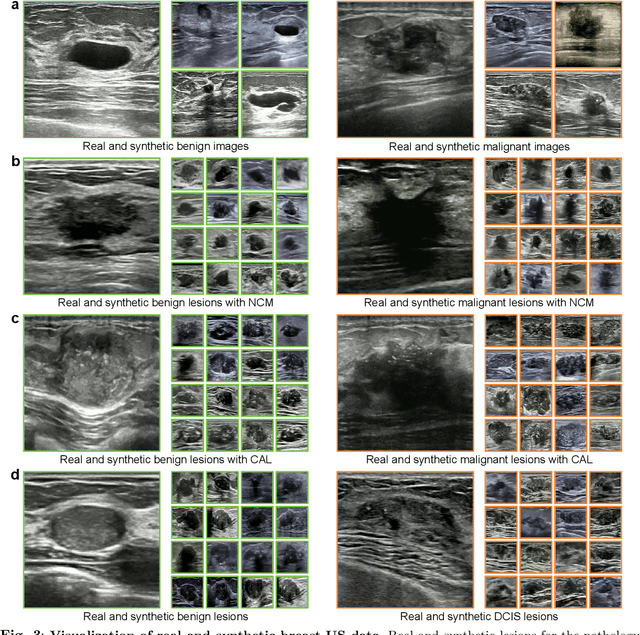
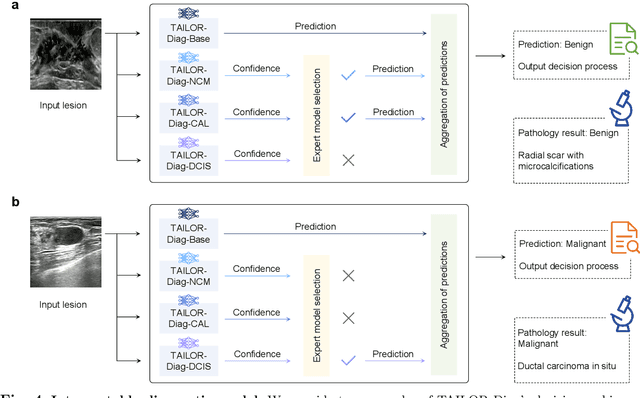
Abstract:Data-driven deep learning models have shown great capabilities to assist radiologists in breast ultrasound (US) diagnoses. However, their effectiveness is limited by the long-tail distribution of training data, which leads to inaccuracies in rare cases. In this study, we address a long-standing challenge of improving the diagnostic model performance on rare cases using long-tailed data. Specifically, we introduce a pipeline, TAILOR, that builds a knowledge-driven generative model to produce tailored synthetic data. The generative model, using 3,749 lesions as source data, can generate millions of breast-US images, especially for error-prone rare cases. The generated data can be further used to build a diagnostic model for accurate and interpretable diagnoses. In the prospective external evaluation, our diagnostic model outperforms the average performance of nine radiologists by 33.5% in specificity with the same sensitivity, improving their performance by providing predictions with an interpretable decision-making process. Moreover, on ductal carcinoma in situ (DCIS), our diagnostic model outperforms all radiologists by a large margin, with only 34 DCIS lesions in the source data. We believe that TAILOR can potentially be extended to various diseases and imaging modalities.
When Box Meets Graph Neural Network in Tag-aware Recommendation
Jun 17, 2024



Abstract:Last year has witnessed the re-flourishment of tag-aware recommender systems supported by the LLM-enriched tags. Unfortunately, though large efforts have been made, current solutions may fail to describe the diversity and uncertainty inherent in user preferences with only tag-driven profiles. Recently, with the development of geometry-based techniques, e.g., box embedding, diversity of user preferences now could be fully modeled as the range within a box in high dimension space. However, defect still exists as these approaches are incapable of capturing high-order neighbor signals, i.e., semantic-rich multi-hop relations within the user-tag-item tripartite graph, which severely limits the effectiveness of user modeling. To deal with this challenge, in this paper, we propose a novel algorithm, called BoxGNN, to perform the message aggregation via combination of logical operations, thereby incorporating high-order signals. Specifically, we first embed users, items, and tags as hyper-boxes rather than simple points in the representation space, and define two logical operations to facilitate the subsequent process. Next, we perform the message aggregation mechanism via the combination of logical operations, to obtain the corresponding high-order box representations. Finally, we adopt a volume-based learning objective with Gumbel smoothing techniques to refine the representation of boxes. Extensive experiments on two publicly available datasets and one LLM-enhanced e-commerce dataset have validated the superiority of BoxGNN compared with various state-of-the-art baselines. The code is released online
Choroidal Vessel Segmentation on Indocyanine Green Angiography Images via Human-in-the-Loop Labeling
Jun 04, 2024Abstract:Human-in-the-loop (HITL) strategy has been recently introduced into the field of medical image processing. Indocyanine green angiography (ICGA) stands as a well-established examination for visualizing choroidal vasculature and detecting chorioretinal diseases. However, the intricate nature of choroidal vascular networks makes large-scale manual segmentation of ICGA images challenging. Thus, the study aims to develop a high-precision choroidal vessel segmentation model with limited labor using HITL framework. We utilized a multi-source ICGA dataset, including 55 degree view and ultra-widefield ICGA (UWF-ICGA) images for model development. The choroidal vessel network was pre-segmented by a pre-trained vessel segmentation model, and then manually modified by two ophthalmologists. Choroidal vascular diameter, density, complexity, tortuosity, and branching angle were automatically quantified based on the segmentation. We finally conducted four cycles of HITL. One hundred and fifty 55 degree view ICGA images were used for the first three cycles (50 images per cycle), and twenty UWF-ICGA images for the last cycle. The average time needed to manually correct a pre-segmented ICGA image per cycle reduced from 20 minutes to 1 minute. High segmentation accuracy has been achieved on both 55 degree view ICGA and UWF-ICGA images. Additionally, the multi-dimensional choroidal vascular parameters were significantly associated with various chorioretinal diseases. Our study not only demonstrated the feasibility of the HITL strategy in improving segmentation performance with reduced manual labeling, but also innovatively introduced several risk predictors for choroidal abnormalities.
Knowledge Graph Pruning for Recommendation
May 19, 2024

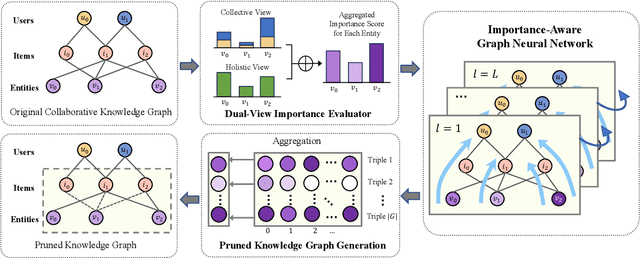
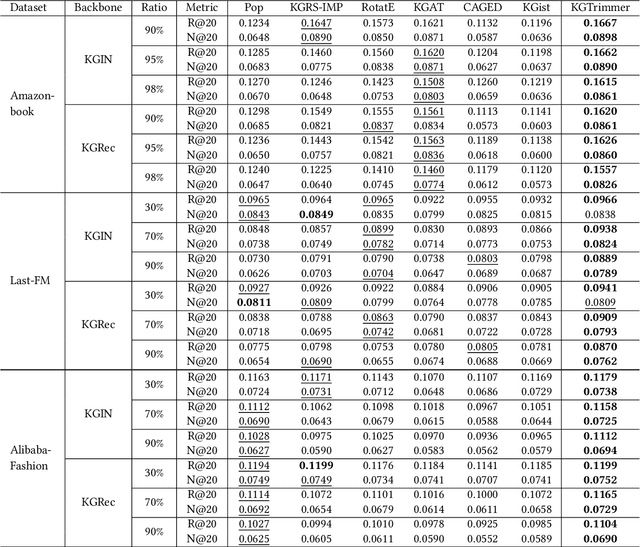
Abstract:Recent years have witnessed the prosperity of knowledge graph based recommendation system (KGRS), which enriches the representation of users, items, and entities by structural knowledge with striking improvement. Nevertheless, its unaffordable computational cost still limits researchers from exploring more sophisticated models. We observe that the bottleneck for training efficiency arises from the knowledge graph, which is plagued by the well-known issue of knowledge explosion. Recently, some works have attempted to slim the inflated KG via summarization techniques. However, these summarized nodes may ignore the collaborative signals and deviate from the facts that nodes in knowledge graph represent symbolic abstractions of entities from the real-world. To this end, in this paper, we propose a novel approach called KGTrimmer for knowledge graph pruning tailored for recommendation, to remove the unessential nodes while minimizing performance degradation. Specifically, we design an importance evaluator from a dual-view perspective. For the collective view, we embrace the idea of collective intelligence by extracting community consensus based on abundant collaborative signals, i.e. nodes are considered important if they attract attention of numerous users. For the holistic view, we learn a global mask to identify the valueless nodes from their inherent properties or overall popularity. Next, we build an end-to-end importance-aware graph neural network, which injects filtered knowledge to enhance the distillation of valuable user-item collaborative signals. Ultimately, we generate a pruned knowledge graph with lightweight, stable, and robust properties to facilitate the following-up recommendation task. Extensive experiments are conducted on three publicly available datasets to prove the effectiveness and generalization ability of KGTrimmer.
DynLLM: When Large Language Models Meet Dynamic Graph Recommendation
May 13, 2024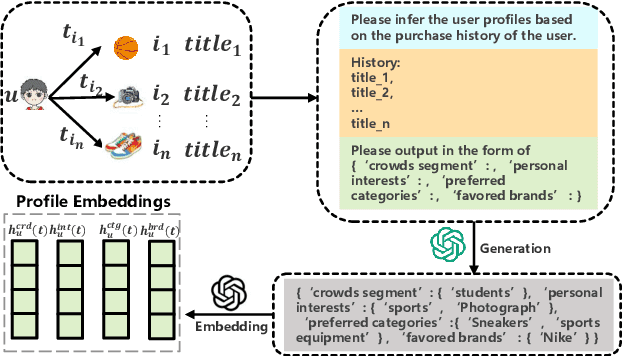
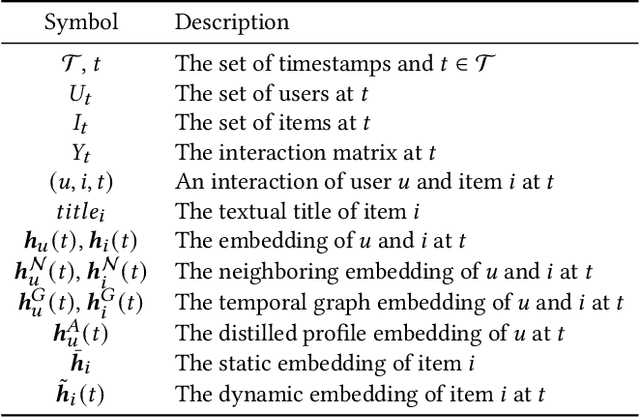
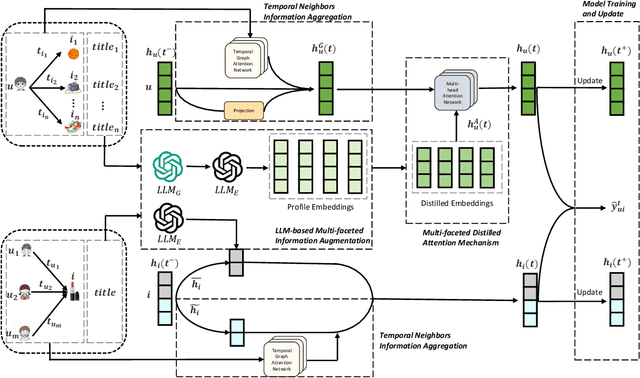
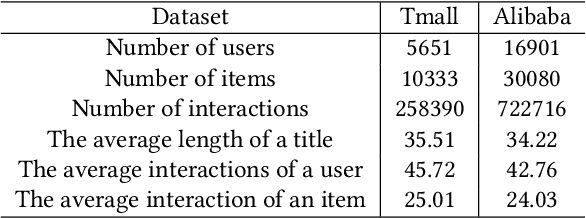
Abstract:Last year has witnessed the considerable interest of Large Language Models (LLMs) for their potential applications in recommender systems, which may mitigate the persistent issue of data sparsity. Though large efforts have been made for user-item graph augmentation with better graph-based recommendation performance, they may fail to deal with the dynamic graph recommendation task, which involves both structural and temporal graph dynamics with inherent complexity in processing time-evolving data. To bridge this gap, in this paper, we propose a novel framework, called DynLLM, to deal with the dynamic graph recommendation task with LLMs. Specifically, DynLLM harnesses the power of LLMs to generate multi-faceted user profiles based on the rich textual features of historical purchase records, including crowd segments, personal interests, preferred categories, and favored brands, which in turn supplement and enrich the underlying relationships between users and items. Along this line, to fuse the multi-faceted profiles with temporal graph embedding, we engage LLMs to derive corresponding profile embeddings, and further employ a distilled attention mechanism to refine the LLM-generated profile embeddings for alleviating noisy signals, while also assessing and adjusting the relevance of each distilled facet embedding for seamless integration with temporal graph embedding from continuous time dynamic graphs (CTDGs). Extensive experiments on two real e-commerce datasets have validated the superior improvements of DynLLM over a wide range of state-of-the-art baseline methods.
 Add to Chrome
Add to Chrome Add to Firefox
Add to Firefox Add to Edge
Add to Edge